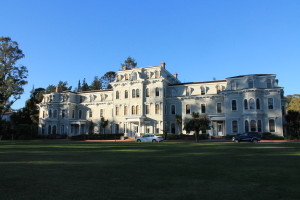
Sunday morning light filters through skylights in the roof, making the soft green walls glow in the space. The room is primed with wellness equipment and spare yoga mats for students who desire to use them. The three students attending the early afternoon, donation-based Stellarflow class are starting to stretch and lay out their mats. Each one of them speaks with their classmates and the instructor, laughing and preparing their bodies for the hour of poses ahead of them. A sense of community connects these individuals, something an onlooker can see clearly in their ease with one another, even though they do not know one another. To someone who has never set foot in a yoga studio before, such as myself, it is incredible to see how something as simple as physical activity can connect folks like this.
The instructor, Marie Grob, walks to the front of the class and motions for the three to come closer to her. She adjusts herself to sit cross-legged on her mat and faces the group.
“It’s nice to have intimate meetings, especially for heart opening,” she says, a soft smile on her face and in her voice. As she begins the class, all three students become intensely focused on the moment and space they are in. “That’s the intent today: opening the heart, embracing vulnerability… [it’s] the only way to accept what is given to us.”
Words like Grob’s opening to her class show the nurturing feeling that permeates Innerstellar Yoga and Pilates.
Located in the heart of Berkeley, California, Innerstellar focuses on being a center of health and healing for students of varying levels of yoga experiences. Yoga studios exist all over the Bay Area and the country, with people from all walks of life trying to find spiritual and physical fulfillment, but Innerstellar is different from other yoga studios in a few specific ways. The instructors here are trained to help heal students’ injuries, both physical and emotional. But while many yoga studios merely strive to be helpful to their students in matters of health, Innerstellar succeeds at truly helping people with their healing processes.
The studio sets itself apart by being one of few in the country to put an emphasis on Forrest Yoga, rather than just offering classes here or there. Started by yoga instructor Ava Forrest, this sect of yoga emphasizes how to take an emotional experience from one’s yoga mat and apply it into their every day life. Innerstellar’s signature style is derivative of Forrest–something they call Stellarflow, which Grob teaches on Sunday mornings.
Stellarflow’s combination of strength building and hands on assistance allows for a tighter student-teacher bond that creates an atmosphere for those new to yoga see the benefits of a different approach. At several points in her class, Grob gets up from doing poses to help a student’s form, telling them softly to breathe into her bracing hand or make a readjustment to their form, always while encouraging their progress. If someone has trouble doing the exact pose, she suggests modifications so they do not have to strain their body.
“Everyone looks pretty darn good,” Grob says as she prepares to switch poses.
Students are the real testament to what Innerstellar offers, though. Alexandra Greene, a columnist for The Campanil, is by no means a novice to yoga. She has practiced it for over a decade and is currently finishing up her training to teach it. However, it was not until nearly two years ago, when she discovered Innerstellar, that she realized the healing properties yoga held, Stellarflow in particular. Greene, who uses yoga to help with her mental health, says Stellarflow yoga helps her be more in touch with her own body and in moving forward.
“It helps with the things I didn’t have words for,” Greene says.
And it is not just practicing Stellarflow that helps her cope. Greene attributes much of her progress to the community that she has built at Innerstellar. She sits in on Grob’s classes on Sundays, despite them being beginner classes, because she knows that everyone at the studio supports her. Even though they may not know one another outside the studio’s green walls, people can identify with one another based on the knowledge of traumas and injuries. Frequently, being in a space as accepting as this combined with the emotional act of engaging in Stellarflow, people will be moved to tears on their mats. Of all the studios that Greene has been to over the years, Innerstellar is the only place she has ever allowed others to see her vulnerable in this way.
“It’s very sacred to be in a space where you bond without telling your whole life story,” she says.
As the Sunday hour draws to a close, the sounds of the three students’ calm inhales and exhales continues as if they had begun the class rather than wrapping it up. It is truly intense to witness people so focused on their breathing and bodies that they do not even realize when tears begin to fall down their cheeks. Grob told them at the beginning of the class to make space around their hearts, without regard for the sounds of the city that managed to penetrate through the walls of the studio. They have managed to do just that.
“Feel for the space you might have created around your heart,” Grob says as she prepares to close the session for the day. “The light in me recognizes and honors the light in you. Namaste.”


